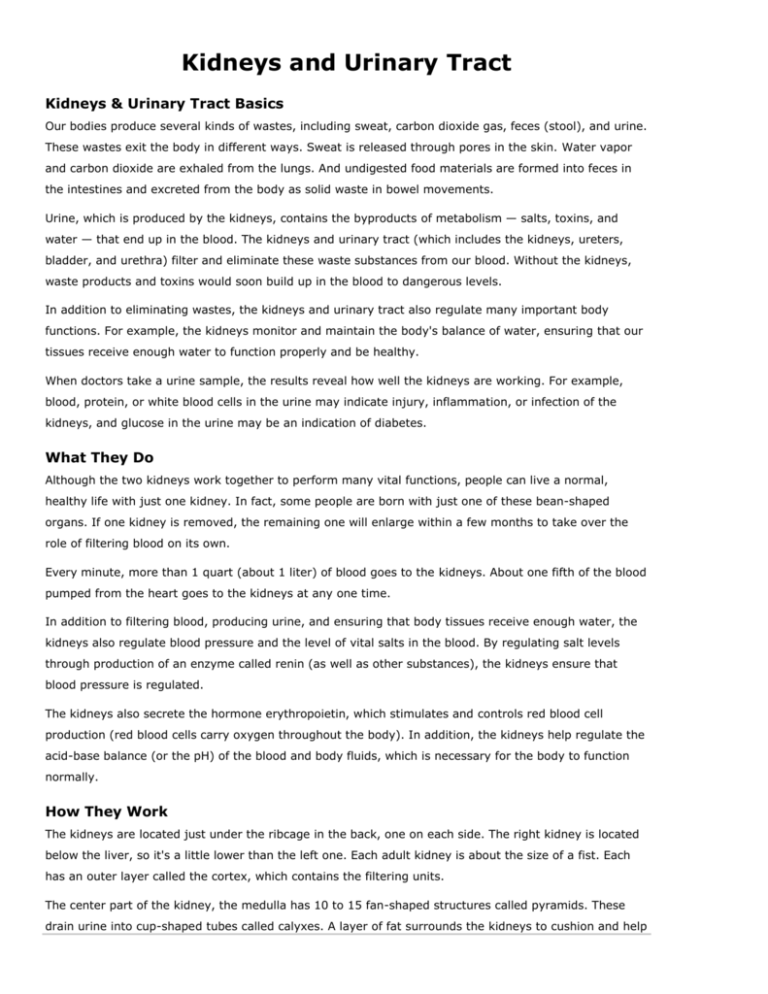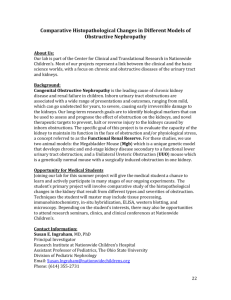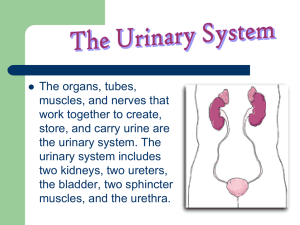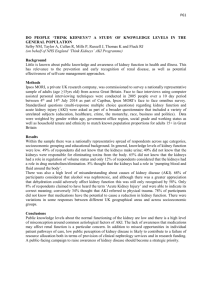
Kidneys and Urinary Tract
Kidneys & Urinary Tract Basics
Our bodies produce several kinds of wastes, including sweat, carbon dioxide gas, feces (stool), and urine.
These wastes exit the body in different ways. Sweat is released through pores in the skin. Water vapor
and carbon dioxide are exhaled from the lungs. And undigested food materials are formed into feces in
the intestines and excreted from the body as solid waste in bowel movements.
Urine, which is produced by the kidneys, contains the byproducts of metabolism — salts, toxins, and
water — that end up in the blood. The kidneys and urinary tract (which includes the kidneys, ureters,
bladder, and urethra) filter and eliminate these waste substances from our blood. Without the kidneys,
waste products and toxins would soon build up in the blood to dangerous levels.
In addition to eliminating wastes, the kidneys and urinary tract also regulate many important body
functions. For example, the kidneys monitor and maintain the body's balance of water, ensuring that our
tissues receive enough water to function properly and be healthy.
When doctors take a urine sample, the results reveal how well the kidneys are working. For example,
blood, protein, or white blood cells in the urine may indicate injury, inflammation, or infection of the
kidneys, and glucose in the urine may be an indication of diabetes.
What They Do
Although the two kidneys work together to perform many vital functions, people can live a normal,
healthy life with just one kidney. In fact, some people are born with just one of these bean-shaped
organs. If one kidney is removed, the remaining one will enlarge within a few months to take over the
role of filtering blood on its own.
Every minute, more than 1 quart (about 1 liter) of blood goes to the kidneys. About one fifth of the blood
pumped from the heart goes to the kidneys at any one time.
In addition to filtering blood, producing urine, and ensuring that body tissues receive enough water, the
kidneys also regulate blood pressure and the level of vital salts in the blood. By regulating salt levels
through production of an enzyme called renin (as well as other substances), the kidneys ensure that
blood pressure is regulated.
The kidneys also secrete the hormone erythropoietin, which stimulates and controls red blood cell
production (red blood cells carry oxygen throughout the body). In addition, the kidneys help regulate the
acid-base balance (or the pH) of the blood and body fluids, which is necessary for the body to function
normally.
How They Work
The kidneys are located just under the ribcage in the back, one on each side. The right kidney is located
below the liver, so it's a little lower than the left one. Each adult kidney is about the size of a fist. Each
has an outer layer called the cortex, which contains the filtering units.
The center part of the kidney, the medulla has 10 to 15 fan-shaped structures called pyramids. These
drain urine into cup-shaped tubes called calyxes. A layer of fat surrounds the kidneys to cushion and help
hold them in place.
Here's how the kidneys filter blood: Blood travels to each kidney through the renal artery, which enters
the kidney at the hilus, the indentation in the kidney that gives it its bean shape. As it enters the cortex,
the artery branches to envelope the nephrons — 1 million tiny filtering units in each kidney that remove
the harmful substances from the blood.
Each of the nephrons contain a filter called the glomerulus, which contains a network of tiny blood
vessels known as capillaries. The fluid filtered from the blood by the glomerulus then travels down a tiny
tube-like structure called a tubule, which adjusts the level of salts, water, and wastes that are excreted
in the urine.
Filtered blood leaves the kidney through the renal vein and flows back to the heart.
The continuous blood supply entering and leaving the kidneys gives the kidneys their dark red color.
While the blood is in the kidneys, water and some of the other blood components (such as acids, glucose,
and other nutrients) are reabsorbed back into the bloodstream. Left behind is urine. Urine is a
concentrated solution of waste material containing water, urea, a waste product that forms when
proteins are broken down), salts, amino acids, byproducts of bile from the liver, ammonia, and any
substances that cannot be reabsorbed into the blood. Urine also contains urochrome, a pigmented
breakdown product of blood that gives urine its yellowish color.
The renal pelvis, located near the hilus, collects the urine flowing from the calyxes. From the renal pelvis,
urine is transported out of the kidneys through the ureters, tubes that carry the urine out of each kidney
to be stored in the urinary bladder — a muscular collection sac in the lower abdomen.
The bladder expands as it fills and can hold about 2 cups (half a liter) of urine at any given time (an
average adult produces about 6 cups, or 1½ liters, of urine per day). An adult needs to produce and
excrete at least one third of this amount in order to adequately clear waste products from the body.
Producing too much or not enough urine may indicate illness.
When the bladder is full, nerve endings in its wall send impulses to the brain. When a person is ready to
urinate, the bladder walls contract and the sphincter (a ring-like muscle that guards the exit from the
bladder to the urethra) relaxes. The urine is ejected from the bladder and out of the body through the
urethra, another tube-like structure. The male urethra ends at the tip of the penis; the female urethra
ends just above the vaginal opening.
Kidneys and Urinary Tract Problems
Like other systems in the body, the entire urinary tract is subject to diseases and disorders.
In kids, the more common problems include:
Congenital problems of the urinary tract. As a fetus develops in the womb, any part of the urinary
tract can grow to an abnormal size or in an abnormal shape or position. One common congenital
abnormality (an abnormality that exists at birth) is duplication of the ureters, in which a kidney has two
ureters coming from it instead of one. This defect occurs in about 1 out of every 125 births and can
cause the kidney to develop problems with repeated infections and scarring over time.
Another congenital problem is horseshoe kidney, where the two kidneys are fused (connected) into one
arched kidney that usually functions normally, but is more prone to develop problems later in life. This
condition is found in 1 out of every 500 births.
Glomerulonephritis is an inflammation of the glomeruli, the parts of the filtering units (nephrons) of the
kidney that contain a network of capillaries (tiny blood vessels). The most common form is poststreptococcal glomerulonephritis, which usually occurs in young children following a case of strep throat.
Most kids with this type of nephritis recover fully, but a few can have permanent kidney damage that
eventually requires dialysis or a kidney transplant.
High blood pressure (or hypertension) can result when the kidneys are impaired by disease. The kidneys
control blood pressure by regulating the amount of salt in the body. They also produce the enzyme renin
that, along with other substances, controls the constriction of muscle cells in the walls of the blood
vessels, which affects a person’s blood pressure.
Kidney (renal) failure can be acute (sudden) or chronic (occurring over time and usually long lasting
or permanent). In either form of kidney failure, the kidneys slow down or stop filtering blood effectively,
causing waste products and toxic substances to build up in the blood.
Acute kidney failure may be due to many things, including a bacterial infection, injury, shock, heart
failure, poisoning, or drug overdose. Treatment includes correcting the problem that led to the failure
and sometimes requires surgery or dialysis. Dialysis involves using a machine or other artificial device to
remove the excess salts and water and other wastes from the body when the kidneys are unable to
perform this function.
Chronic kidney failure involves a deterioration of kidney function over time. In children, it can result from
acute kidney failure that fails to improve, birth defects of the kidney, chronic kidney diseases, repeated
kidney infections, or chronic severe high blood pressure. If diagnosed early, chronic kidney failure in
children can be treated but usually not reversed. The child may require a kidney transplant at some point
in the future.
Kidney stones (or nephrolithiasis) result from the buildup of crystallized salts and minerals such as
calcium in the urinary tract. Stones (also called calculi) can also form after an infection. If kidney stones
are large enough to block the kidney or ureter, they can cause severe abdominal pain. But the stones
usually pass through the urinary tract on their own. In some cases, they may need to be removed
surgically.
Nephritis is any inflammation of the kidney. It can be caused by infection, medications, an autoimmune
disease (such as lupus), or it may be idiopathic (which means the exact cause may not be known or
understood). Nephritis is generally detected by protein and blood in the urine.
Nephrotic syndrome is a type of kidney disease that leads to loss of protein in the urine and swelling of
the face (often the eyes) or body (often around the genitals). It is most common in children younger
than 6 years old and is more prevalent in boys. Nephrotic syndrome is often treated with steroids.
Urinary tract infections (UTIs) are usually caused by intestinal bacteria, such as E. coli, normally
found in feces. These bacteria can cause infections anywhere in the urinary tract, including the kidneys.
Most UTIs occur in the lower urinary tract, in the bladder and urethra. UTIs occur in both boys and girls.
In school-age children, girls are more likely to develop UTIs than boys; this may be because girls have
shorter urethras than boys.
Vesicoureteral reflux (VUR) is a condition in which urine abnormally flows backward (or refluxes) from
the bladder into the ureters. It may even reach the kidneys, where infection and scarring can occur over
time. VUR occurs in 1% of children and tends to run in families. It's often detected after a young child
has a first urinary tract infection. Most kids outgrow mild forms of VUR, but some can develop permanent
kidney damage and kidney failure later in life.
Wilms' tumor is the most common kidney cancer occurring in children. It is diagnosed most commonly
between 2 and 5 years of age and affects males and females equally.
Reviewed by: Yamini Durani, MD Date reviewed: October 2012
© 1995- 2014 The Nemours Foundation. All rights reserved.









